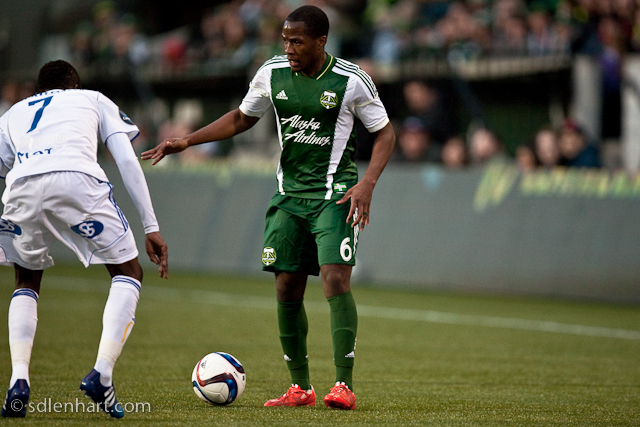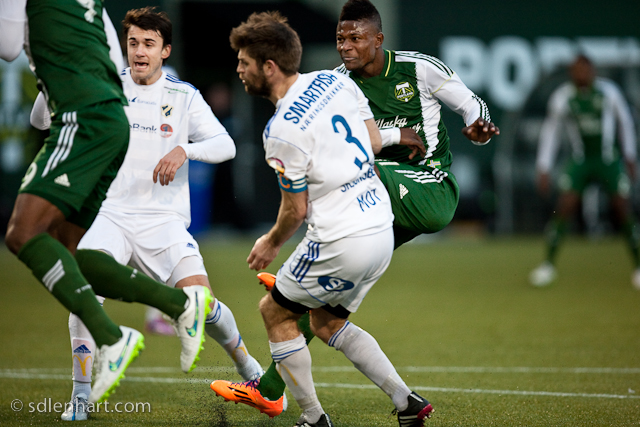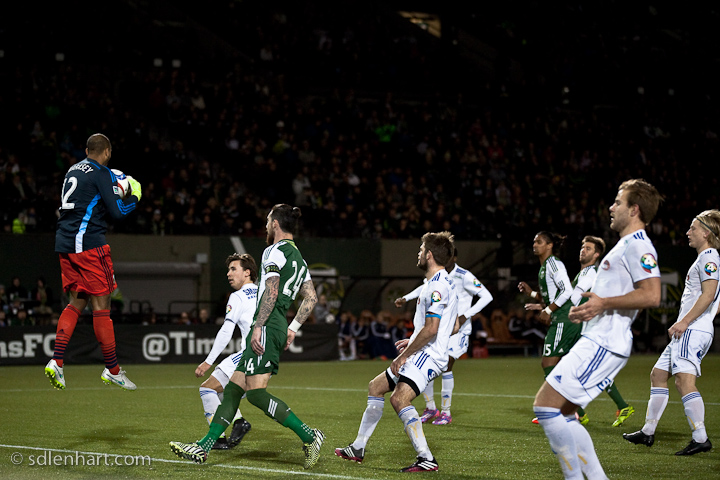Prematch – Timbers v Real Salt Lake
I’m not sure this game even gets played given the division between the owners and players over free agency. For now, though, I’ll offer up my thoughts with an expectation that a deal will be reached.
If you’ve been reading any articles on Real Salt Lake this pre-season you’ve probably seen they have been running a 4-3-3 as opposed to a Diamond 4-4-2. For some that may mean a whole lot – for me it really boils down to this – within the Diamond 4-4-2 a team is more likely to work wide in the midfield and then more narrow towards goal.
Meaning in attack they are more likely to play the ball on the ground towards the center (atop the 18) and then look to create additional time and space either left or right of that central penetration…using either striker.
With the 4-3-3, on the other hand, a team is more likely to play narrow in the midfield – towards center – and then pop the ball out wide for penetration – in turn perhaps offering up a few more crosses, or aeriel balls, to gain penetration and make space for others. That outwide movement can and usually does include a fullback – ususally in an overlapping position. Crafty teams, in attack, may also leverage inverted wingers in that system.
And while the tendency seems to be towards moving the ball on the ground it is acceptable for a team to leverage crosses as well… and that frequency is sometimes dictated more by what the opponent does as opposed to the attacker – afterall – if a defending unit is going to play narrow then the attacking unit will take advantage of that space – the difference in scoring or not scoring can then become an aerial battle.
Here’s a look at some supplemental statistics for Real Salt Lake last year:
- The more crosses offered by RSL the less likely they were to earn points.
- The more corners won by RSL the slightly less likely they were to earn points.
- The more Yellow cards the Opponent had the less likely RSL were to earn points.
- The more Fouls, suffered by RSL, in the Opponents Defending Final 3rd the less likely RSL were to earn points.
- The more clearances the Opponent had the less likely RSL were to earn points.
- Eight of 21 Goals Scored came from Set Pieces (Away Games Only) – 18 of 33 Goals Scored came from Set Pieces (Home Games Only)
- 18 of those 21 Goals Scored came from a right footed strike – while one was left footed and two came from headers.
- 57% of all the goals scored by RSL have targeted the lower left side (goal keepers right side) of the net.
In conclusion – given the info it appears RSL played more successfully on the ground than in the air – with the 4-3-3 it is likely those statistics change somewhat this year. In addition they can score from Set-Pieces (over one-third of their away goals came from Set-Pieces) – and if Adam Kwarasey has done his homework we may see him lean (ever-so-slightly) towards his right…
From a defensive standpoint here’s a look at how their opponent’s performed against them last year:
- The more Opponent Crosses offered the more likely RSL was to earn points.
- The more Opponent Corners offered the more likely RSL was to earn points.
- The more Yellow Cards garnered by RSL the more likely RSL were to earn points.
- The more fouls RSL makes in their Defending Final 3rd the more likely RSL are to earn points.
- The more defensive clearances RSL had the more likely RSL were to earn points.
- 25 Goals were conceded by RSL in Away Games.
- 14 from right footed strikes, seven from left footed strikes, 3 from headers and 1 from ‘other’.
- 40% of all goals conceded by RSL have targeted the left lower side (Nick Rimando’s right lower side) of the net.
In conclusion – teams playing through the air were less succesful than those playing ground-based passing – the approach in RSL defending is not likely to have changed – therefore it would seem reasonable that the Timbers will look to penetrate on the ground a wee bit more than in the air. And like the Timbers – teams scored more on Rimando’s right side than his left side – meaning right footed strikes to the far post (from the right side) are more likely to get past Rimando.
Now for a few bits and pieces on the Timbers, in attack, from last year:
- The more crosses offered by PTFC the less likely they were to earn points.
- The more corners won by PTFC the less likely they were to earn points.
- There is no relationship in Opponent Yellow cards and PTFC earning points.
- The is no relationship in PTFC suffering fouls in the Opponent’s Defending Final Third and earning points.
- There is no relationship in Opponent Clearances and PTFC earning points.
- 12 of 61 Goals Scored came from Set Pieces (six from corners, four from PK’s, 1 Direct FK, and 1 Cross FK).
- 41 of those 61 Goals Scored came from a right footed strike – while 15 were left footed and five came from headers.
- 51% of all the goals scored by PTFC targeted the left side (goal keepers right side) of the net with 37% of all goals targeting the lower left side.
In conclusion – like RSL, the Timbers were more successful when not crossing the ball as frequently as some other teams – and when it came to scoring goals they had 49 that came from conditions other than Set-Pieces (61 in total). Those are some dominating attacking statistics – but as we saw last year it wasn’t about the attack – it was about defending.
The same info but how the opponent performed against Portland last year:
- The slightly more Opponent Crosses offered the slightly more likely PTFC was to earn points.
- There is no relationship between the number of Opponent Corners offered and PTFC earning points.
- The slightly more Yellow Cards garnered by PTFC the slightly less likely PTFC were to earn points.
- The slightly more fouls PTFC makes in their Defending Final 3rd the slightly more likely PTFC are to earn points.
- The more defensive clearances PTFC had the more likely PTFC were to earn points.
- 52 Goals were conceded by PTFC.
- 24 from right footed strikes, 17 from left footed strikes, 10 from headers.
- 37% of all goals conceded by PTFC have targeted the left side while 41% of all goals conceded targeted the right side (facing the net). 33% of all goals scored by the Opponent targeted the lower left and 33% of all goals scored by the Opponent targeted the lower right.
In conclusion – Teams pretty much scored on either side of Ricketts last year – meaning the opponent had plenty of time and space to shoot at will – at least until the last third of the season. The Timbers had five clean sheets from Game 26 – but during that same time span they also had two games where the opponent scored three goals – one of them being that meltdown in Toronto…
So who lines up for Portland?
I think we see Adi, with Wallace on the left, Asprilla on the right and Darlington in the middle (as the four primary attackers.
This doesn’t mean Nagbe doesn’t rotate left or right – if he rolls left, towards Wallace we may see this from Asprilla:
With all that said what we really want to see is:
- A game of footy played this Saturday,
- This…, and

Fanendo Adi nets the games only goal and then consults with a teammate on his way back to the center circle.
- This…
In the Midfield it is likely Jack Jewsbury starts in place of Ben Zemanski – while Diego Chara, if healthy, gets his normal slot – if not perhaps it’s Blair Gavin??? and then George Fochive on the subs bench???
With respect to the back-four – the Capt. Obvious here is Powell, Borchers, Ridgewell, and Villafana with Kwarasey in goal…
For the subs bench I’d go with Gaston, Maxi, Nano, Gavin?, Paparatto, Jeanderson, and Weber (if Gleeson remains injured)…
In Closing:
2015 marks the fifth year of Portland Timbers football in the MLS – soccer is growing.
Even you want to listen to what myself, Nevets, and my co-host Stephen Brandt think about this upcoming game give this podcast a listen… @yellowcardedpod.
It’s all to play for —-> provided they play…
Best, Chris



